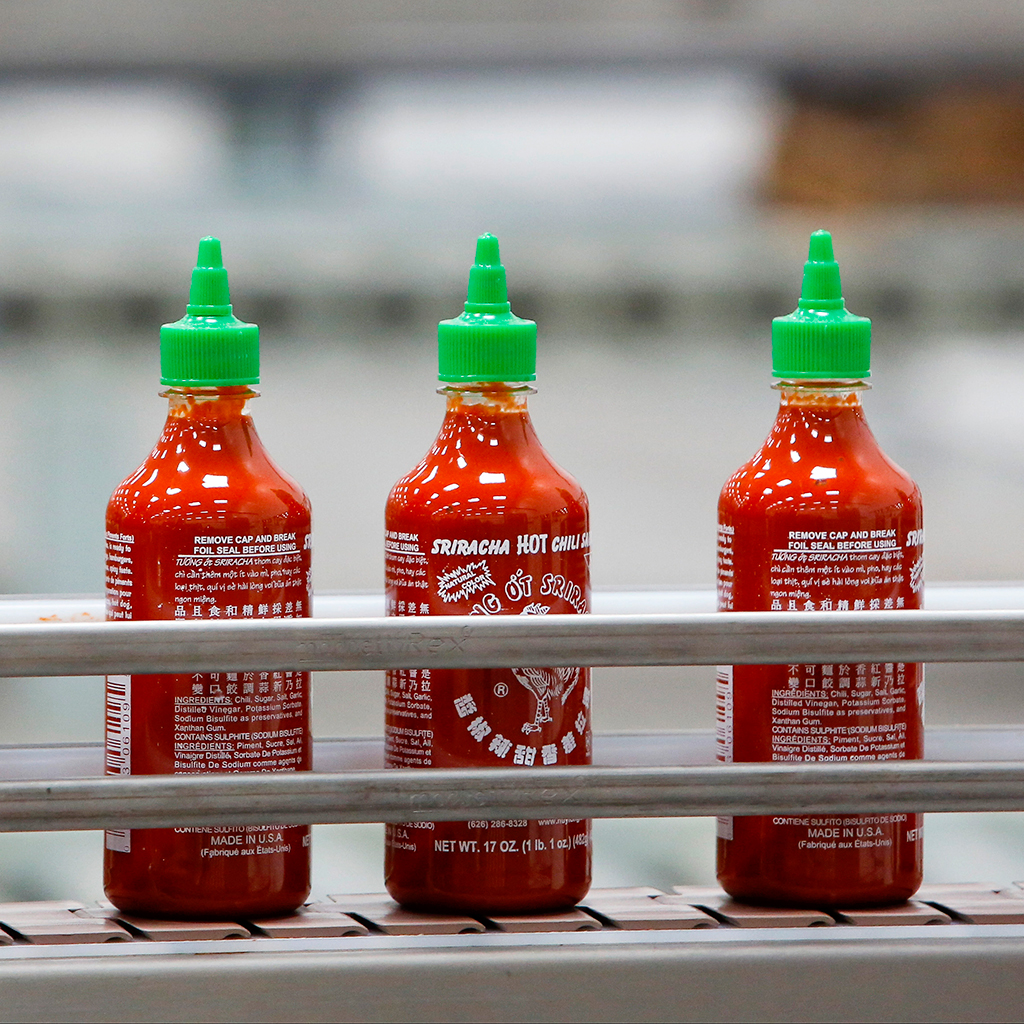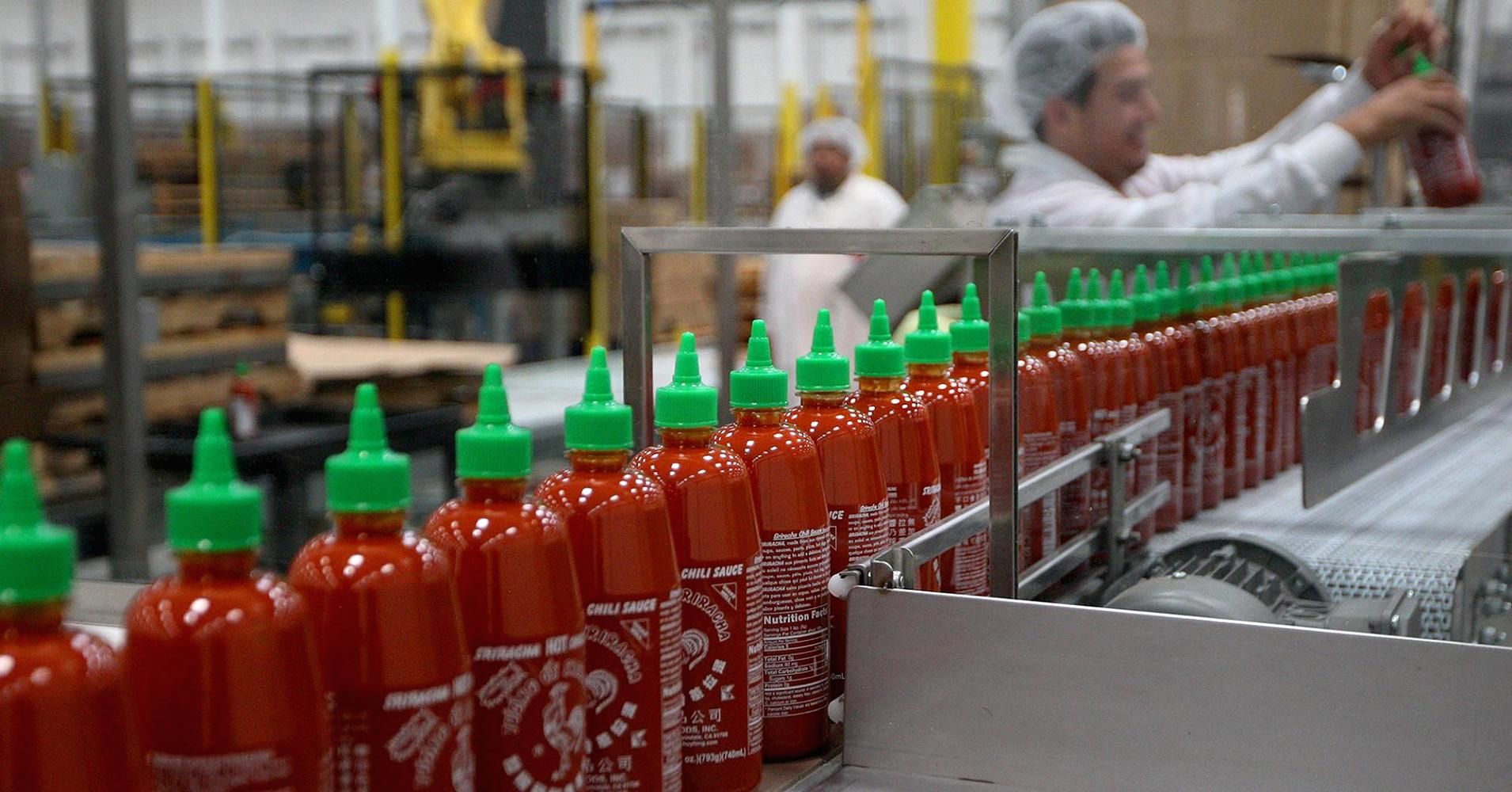After settling in Los Angeles in 1979, Tran founded Huy Fong Foods Inc., named for the Huey Fong boat that brought him to the U.S., and started making hot sauces for local Asian restaurants. He earned $2,300 in the first month of selling his creations out of a blue van hand-painted with the brand’s iconic rooster. (Tran, who is ethnically Chinese, was born in the year of the rooster.)

Now, almost four decades later, Huy Fong controls 9.9 percent of the $1.55bn American hot-sauce market, according to IBISWorld, an industry researcher.
“I never thought that it would be so popular,” said Tran, who owns the company with his family. “When I left Vietnam I didn’t know how it would be tomorrow, so today God bless me.”

The Huy Fong factory in Irwindale, California, about 20 miles east of downtown Los Angeles, is a pristine facility with silver conveyor belts that each day shuttle hundreds of thousands of bright red bottles of Sriracha and their distinctive green caps into cardboard boxes. The factory, which operates up to 16 hours a day most days of the week, uses 100 million pounds of chilies each year. That’s enough spice to irritate the senses of some Irwindale neighbors.

More than 8,000 miles away in a suburb of Bangkok, factory workers toil without air conditioning as forklifts roll through 90-degree heat hauling boxes of the same kind of chili sauce — this one with a red and yellow label and called Sriraja Panich.
Most Americans haven’t heard of the Thai brand, which claims to be the original Sriracha recipe, and that’s something the family behind the sauce is hoping to change.
“If we can get just 1 percent of market share in the U.S., that would already be huge for us,” said Bancha Winyarat, the 33-year-old vice president of Thaitheparos PCL, which makes Sriraja Panich. The Winyarat family owns a majority of the publicly traded sauce maker, with a market value of more than 8bn Thai baht ($251m).
Sriracha was first made about 80 years ago by Thanom Chakkapak, a woman from Si Racha, Thailand, a coastal town 73 miles south of Bangkok, according to the company’s website. Bancha’s father purchased the Sriraja Panich recipe from Thanom in 1984 — a year after Tran started making his own version of the sauce in L.A.
Soy sauce makes up the bulk of Thaitheparos’s revenue, with chili sauce accounting for just 5 percent, but it’s still the most popular local brand, Winyarat said.
“It’s the taste that people around here are familiar with,” he said.
As Huy Fong’s Tran, the king of American Sriracha, expands in Asia and Thaitheparos targets the U.S. market, both are faced with different tastes and brand loyalties. Tran’s Sriracha uses fresh red jalapenos from across the U.S. while the less viscous Sriraja Panich uses cayenne peppers from northern and central Thailand. Tran said he has never tried Sriraja Panich.
“I like the Thai version more, but maybe that’s because I’m used to the taste,” said Suntaree Tantichula, a Thai chef at a restaurant in Evanston, Illinois. “But I think Americans might prefer Huy Fong sauce because it’s the taste they know.”
Tran’s Sriracha started out as a staple on the tables of L.A. Asian restaurants and grew into a national phenomenon. How Sriracha became so popular across the rest of the country is anyone’s guess, as Huy Fong has never advertised its products. The company’s relative obscurity is perhaps what helped it stand out and seem more authentic, said Anna Amir, an IBISWorld hot-sauce analyst.
The fact that “people hear about it through word of mouth gives it kind of a unique edge in an industry with a lot of advertising,” she said.
When he started the company, Tran struggled to find fresh chilies, so making enough sauce for existing customers was already difficult. Eventually he found one supplier: Camarillo, California-based Underwood Ranches. But after 28 years of it being the exclusive provider of Huy Fong’s chilies, Tran said, a dispute ended the relationship and Underwood went on to make its own Sriracha.
For the past few years, the companies have been enmeshed in a legal battle over advance payments and factory equipment. A trial is scheduled for April 29 in California Superior Court.
“It’s very easy to make it if you have fresh chilies,” said Tran, who now has three U.S. suppliers.
Tran said he has received multiple offers for his company, but he said he won’t consider them because he plans to pass along the business to his children.
Major condiment brands like Tabasco, Frank’s Red Hot and Heinz have introduced their own Sriracha products. Tran welcomes the new entrants because Americans’ appetite for Sriracha is insatiable, he said.
“I never worry about where they are selling more or less because we are too busy making it,” Tran said. “I know that I cannot make enough of my product to meet the demand, so let them have it and work together for the consumer.”



The Most Read
Сryptocurrencies
Bitcoin and Altcoins Trading Near Make-or-Break Levels
Financial crimes
Thieves targeted crypto execs and threatened their families in wide-ranging scheme
Financial crimes
Visa Warning: Hackers Ramp Up Card Stealing Attacks At Gas Stations
News
Capitalism is having an identity crisis – but it is still the best system
Uncategorized
The 73-year-old Vietnamese refugee is responsible for bringing Sriracha to American consumers
Uncategorized
Electric Truckmaker Rivian, Backed By Amazon, Ford, Raises Whopping $1.3 Billion